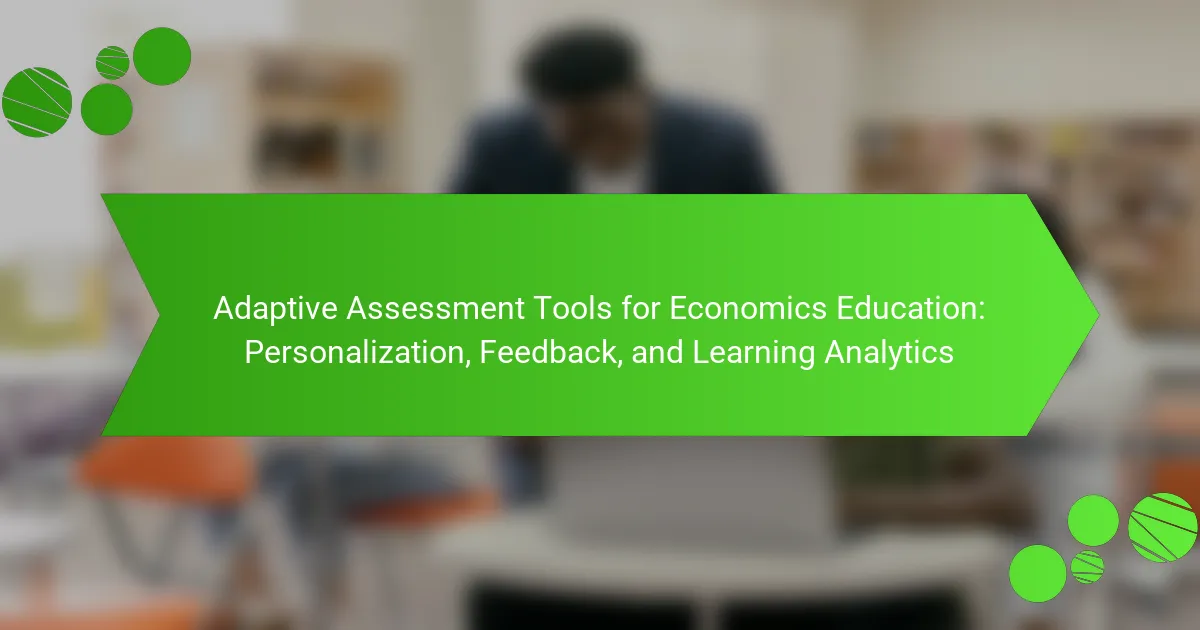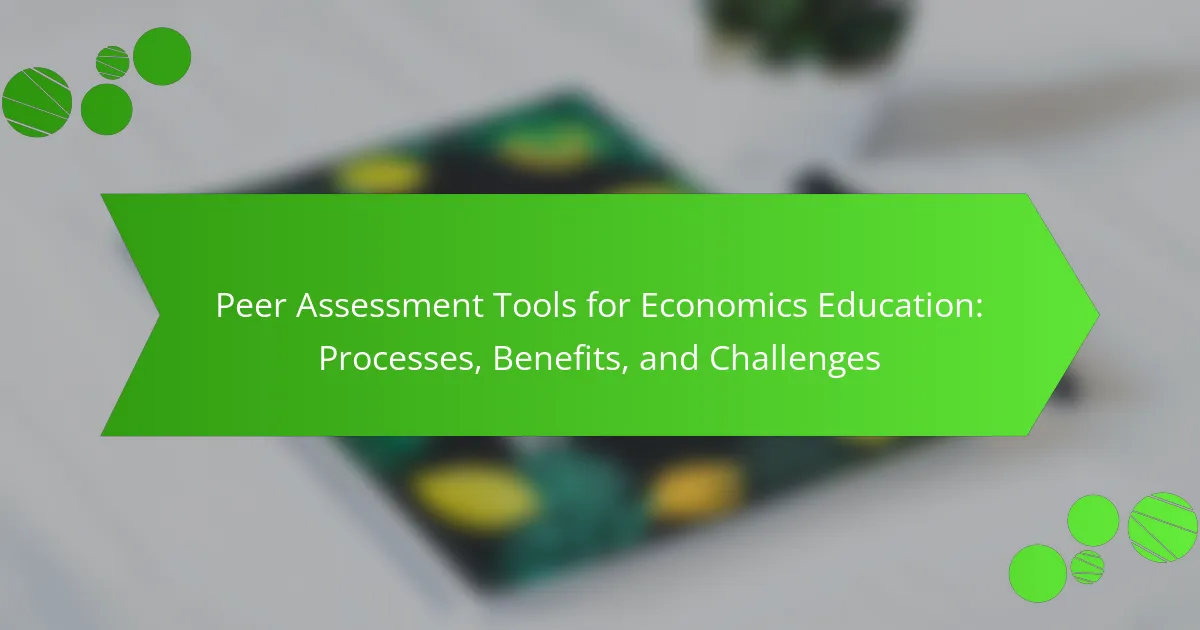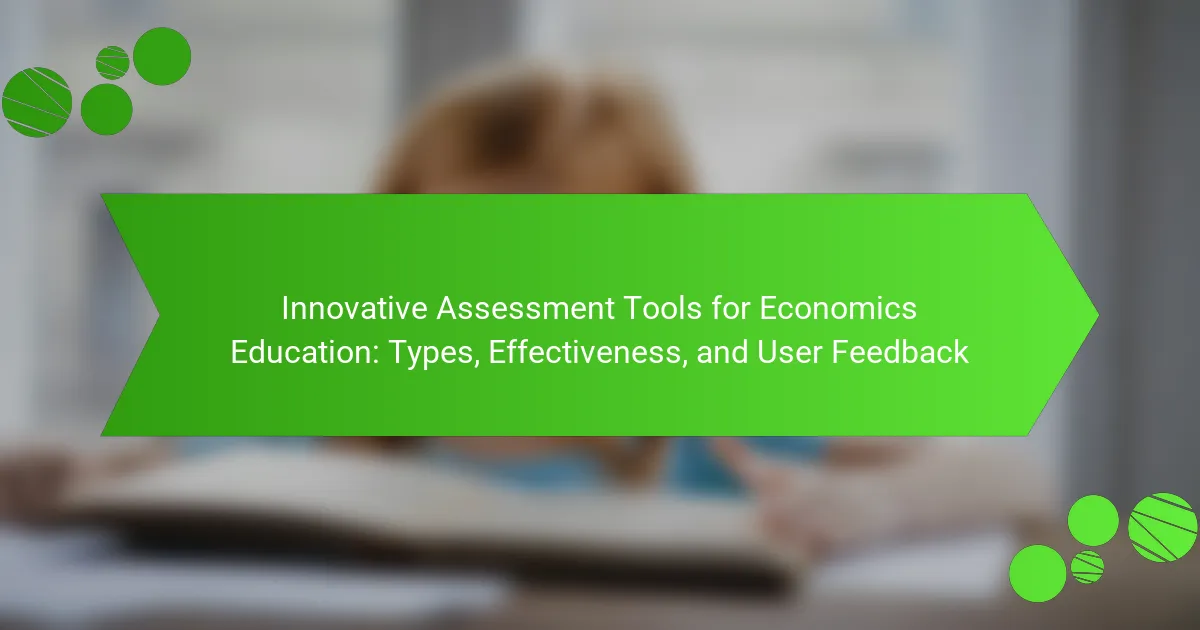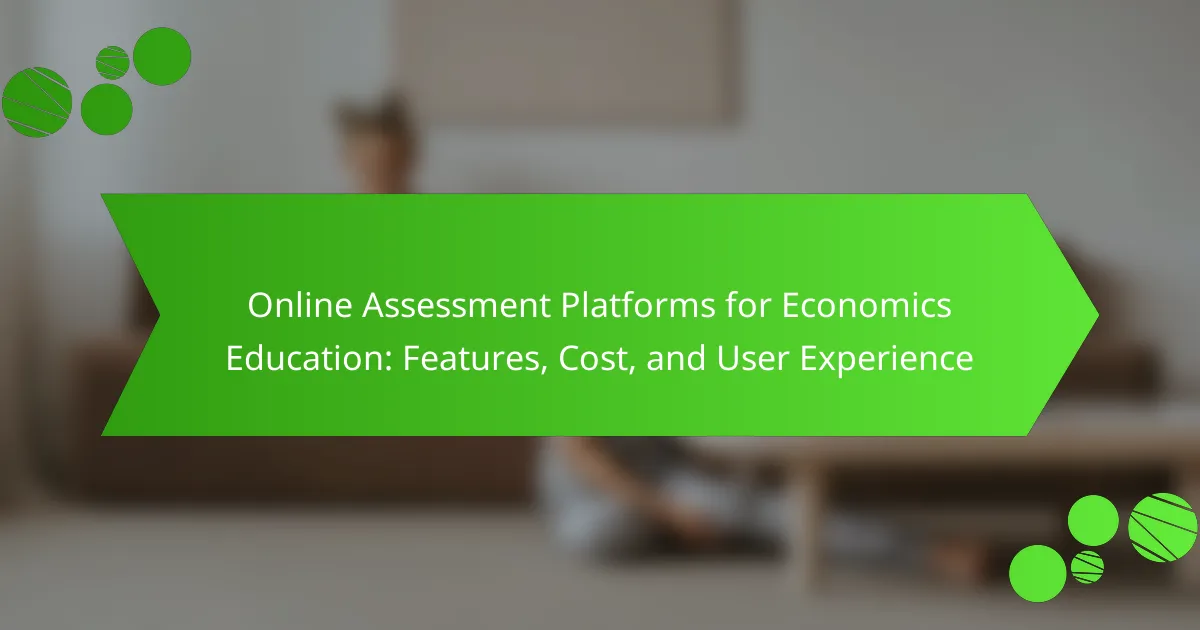Formative assessment tools in economics education are methods designed to evaluate student learning throughout the instructional process, providing ongoing feedback to both students and instructors. These tools, including quizzes, polls, and peer assessments, help identify student challenges, facilitating timely interventions and adjustments in teaching strategies. Best practices for implementing these tools emphasize clear learning objectives, timely feedback, and active student involvement, which enhance engagement and understanding. The effectiveness of formative assessments can be evaluated based on criteria such as alignment with learning objectives, quality of feedback, student engagement levels, data analysis, teacher perceptions, and longitudinal studies. Research indicates that effective formative assessments significantly improve learning outcomes in economics education.
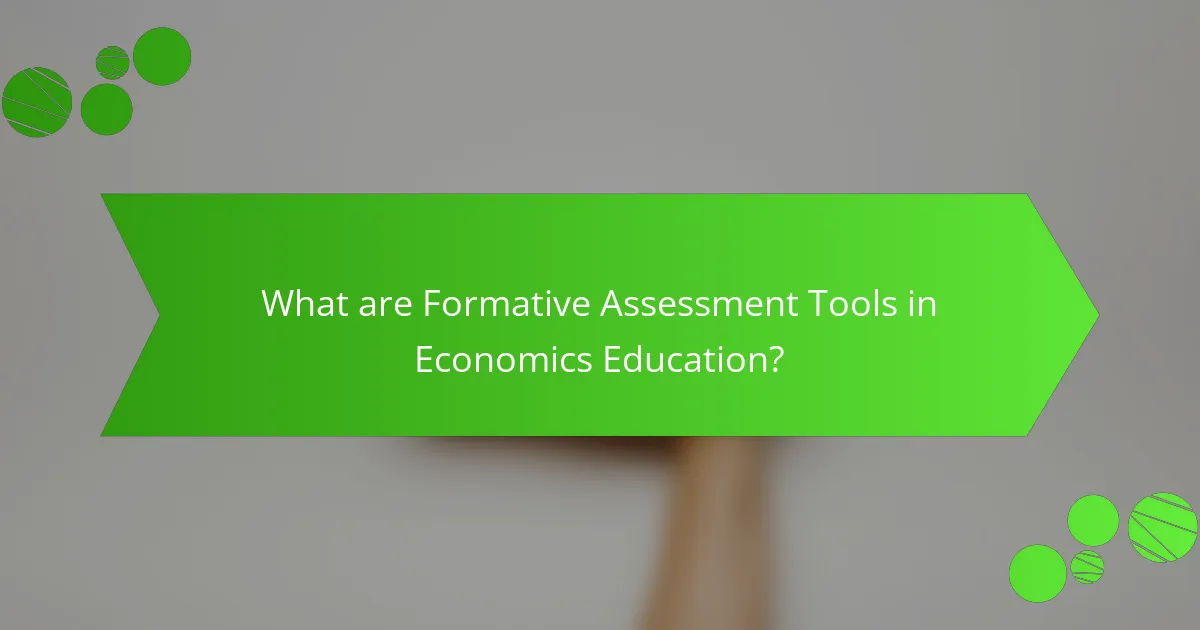
What are Formative Assessment Tools in Economics Education?
Formative assessment tools in economics education are methods used to evaluate student learning during the instructional process. These tools provide ongoing feedback to both students and instructors. Examples include quizzes, polls, and peer assessments. They help identify areas where students struggle. This allows for timely interventions and adjustments in teaching strategies. Research shows that formative assessments can enhance student engagement and understanding. According to the National Council for Economic Education, effective formative assessments improve learning outcomes in economics.
How do formative assessment tools enhance learning in economics?
Formative assessment tools enhance learning in economics by providing immediate feedback to students. These tools allow instructors to gauge student understanding in real-time. For instance, quizzes and polls can identify knowledge gaps. This prompts timely interventions to address misunderstandings. Research indicates that timely feedback improves student performance. A study by Hattie and Timperley (2007) shows that feedback significantly boosts learning outcomes. Additionally, formative assessments encourage active engagement in the learning process. Students become more involved when they receive regular updates on their progress. Overall, these tools foster a deeper understanding of economic concepts.
What types of formative assessment tools are commonly used in economics education?
Common types of formative assessment tools used in economics education include quizzes, polls, and peer assessments. Quizzes can be administered online or in class to gauge student understanding. Polls provide immediate feedback on student opinions and comprehension. Peer assessments involve students evaluating each other’s work, fostering collaborative learning. Additionally, reflective journals encourage students to articulate their learning processes. Concept maps help visualize relationships between economic concepts. These tools enhance engagement and inform teaching strategies.
How do these tools differ from traditional assessment methods?
Formative assessment tools differ from traditional assessment methods by focusing on ongoing feedback rather than final evaluations. Traditional methods often emphasize summative assessments, such as exams or final projects. These assessments measure student learning at the end of an instructional unit. In contrast, formative tools provide real-time insights into student understanding during the learning process. They encourage active participation and engagement through interactive quizzes, peer assessments, and reflective activities. Research shows that formative assessments can significantly enhance student learning outcomes by allowing timely interventions. Studies indicate that students engaged in formative assessments demonstrate higher retention rates and improved performance compared to those relying solely on traditional methods.
Why is student engagement important in economics education?
Student engagement is crucial in economics education because it enhances understanding and retention of complex concepts. Engaged students are more likely to participate actively in discussions and collaborative learning. This active participation leads to deeper comprehension of economic theories and principles. Research indicates that engaged learners perform better academically. For instance, a study by the National Survey of Student Engagement found that high levels of engagement correlate with improved learning outcomes. Furthermore, student engagement fosters critical thinking and analytical skills essential for economics. Engaged students are also more motivated to pursue further studies in the field. Overall, student engagement significantly contributes to effective economics education.
What role do formative assessment tools play in promoting student engagement?
Formative assessment tools enhance student engagement by providing immediate feedback and fostering active learning. These tools, such as quizzes and peer reviews, allow students to understand their progress. They encourage participation by making learning interactive. Research indicates that students who receive timely feedback are more likely to be motivated. A study by Hattie and Timperley (2007) highlights that feedback significantly impacts student achievement. Engaging students through formative assessments leads to a deeper understanding of the material. Overall, these tools create a dynamic learning environment that promotes continuous improvement.
How can formative assessments be tailored to meet diverse student needs?
Formative assessments can be tailored to meet diverse student needs by incorporating varied assessment methods. These methods include quizzes, discussions, and hands-on activities. Differentiation allows educators to adjust the complexity of tasks based on student readiness. Feedback can be personalized to guide individual learning paths. Additionally, using technology can facilitate adaptive assessments that respond to student performance in real-time. Research shows that tailored formative assessments improve student engagement and learning outcomes. For example, a study by Black and Wiliam (1998) highlights that formative assessment practices significantly enhance student achievement.
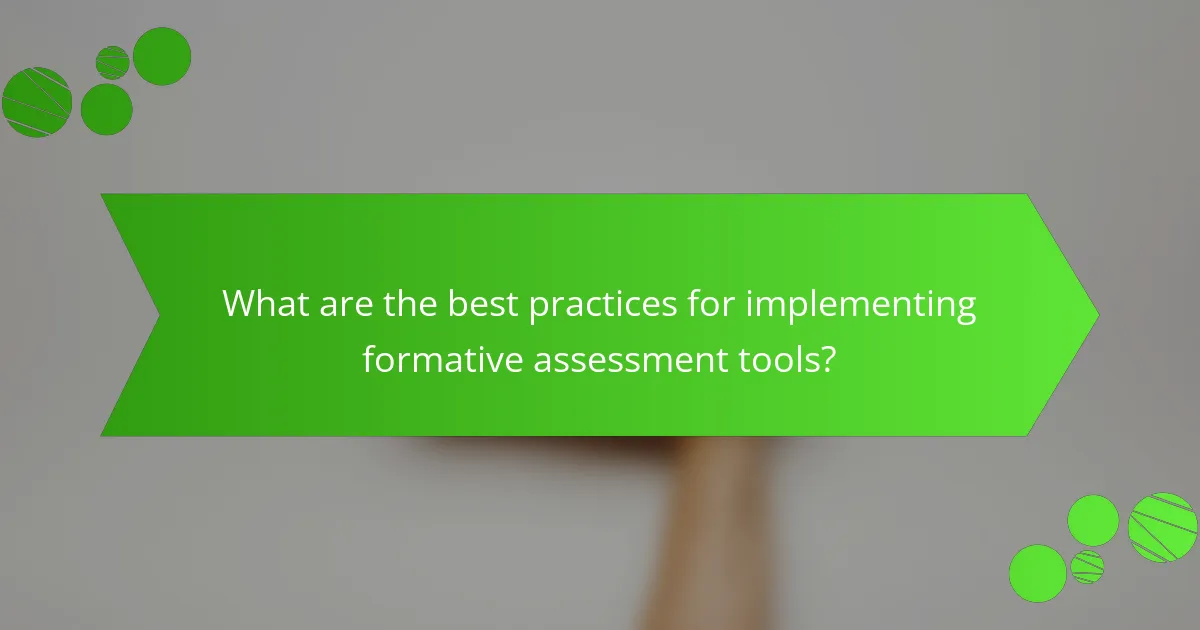
What are the best practices for implementing formative assessment tools?
Best practices for implementing formative assessment tools include clear learning objectives, timely feedback, and student involvement. Establish clear learning objectives to guide assessments. This ensures alignment with course goals. Provide timely feedback to help students understand their progress. Research shows that feedback can improve learning outcomes significantly. Involve students in the assessment process to enhance engagement. Techniques such as peer assessment foster collaboration and critical thinking. Use diverse assessment methods to cater to different learning styles. Incorporate quizzes, discussions, and projects for comprehensive evaluation. Regularly review and adjust assessment tools based on student performance and feedback. Continuous improvement of assessment strategies leads to better educational outcomes.
How can educators effectively integrate formative assessments into their curriculum?
Educators can effectively integrate formative assessments into their curriculum by using varied assessment techniques. These techniques include quizzes, peer assessments, and reflective journals. Regularly incorporating these assessments helps gauge student understanding. Feedback should be timely and constructive to enhance learning. Educators can align assessments with learning objectives for better relevance. Utilizing technology, such as online platforms, can streamline the assessment process. Data from formative assessments can inform instructional adjustments. Research indicates that formative assessments improve student engagement and achievement. A study by Black and Wiliam (1998) found that effective formative assessment can raise student performance by up to 30%.
What strategies can be used to provide timely feedback to students?
Implementing regular formative assessments is a key strategy to provide timely feedback to students. These assessments can include quizzes, polls, and short assignments. They allow educators to gauge student understanding frequently. Additionally, using technology tools like learning management systems can facilitate immediate feedback. For instance, online quizzes can automatically grade and provide scores instantly. Peer feedback is another effective strategy, as it encourages collaboration and reflection among students. Furthermore, setting clear expectations and rubrics helps students understand how they will be assessed. Research shows that timely feedback significantly enhances student learning outcomes. A study by Hattie and Timperley (2007) emphasizes that feedback is one of the most powerful influences on learning.
How can technology enhance the effectiveness of formative assessments?
Technology enhances the effectiveness of formative assessments by providing real-time feedback and data analytics. Digital tools allow educators to track student progress instantly. Platforms like Google Forms or Kahoot enable quick quizzes and polls. These tools facilitate immediate insights into student understanding. Research shows that timely feedback can significantly improve learning outcomes. A study by Hattie and Timperley (2007) indicates that feedback is one of the most powerful influences on student achievement. Additionally, technology can personalize learning experiences. Adaptive learning software adjusts content based on individual student performance. This ensures that assessments are tailored to meet diverse learning needs. Overall, technology streamlines formative assessments and fosters a more engaging learning environment.
What challenges might educators face when using formative assessment tools?
Educators may face several challenges when using formative assessment tools. One challenge is the time required to create and implement these assessments. Research indicates that teachers often struggle to balance assessment with instructional time. Another challenge is interpreting the data collected from assessments. Many educators lack training in data analysis, leading to misinterpretation of student performance. Additionally, educators may encounter resistance from students who are unfamiliar with formative assessments. This resistance can hinder engagement and participation. Lastly, technology issues can arise, such as inadequate access to devices or unreliable internet connections. These factors can limit the effectiveness of formative assessment tools in the classroom.
How can these challenges be overcome to maximize student learning?
To overcome challenges in maximizing student learning, educators should implement tailored formative assessment tools. These tools provide real-time feedback, enabling students to understand their progress. Regular use of quizzes and polls can identify knowledge gaps effectively. Incorporating peer assessments fosters collaborative learning among students. Utilizing technology, such as learning management systems, streamlines the assessment process. Research shows that formative assessments can improve student performance by up to 30% (Black & Wiliam, 1998). Engaging students in self-assessment encourages ownership of their learning journey. By addressing learning challenges through these strategies, educators can enhance overall student engagement and achievement.
What resources are available to support educators in using formative assessments?
Educators can access various resources to support formative assessments. These include online platforms such as Edmodo and Google Classroom, which facilitate real-time feedback. Additionally, professional organizations like the National Council of Teachers of Mathematics provide guidelines and tools. Research articles, like those published in the Journal of Educational Psychology, offer evidence-based strategies. Workshops and webinars hosted by educational institutions also enhance understanding of formative assessment practices. Furthermore, books such as “Embedded Formative Assessment” by Dylan Wiliam provide comprehensive insights. These resources collectively empower educators to effectively implement formative assessments in their teaching.
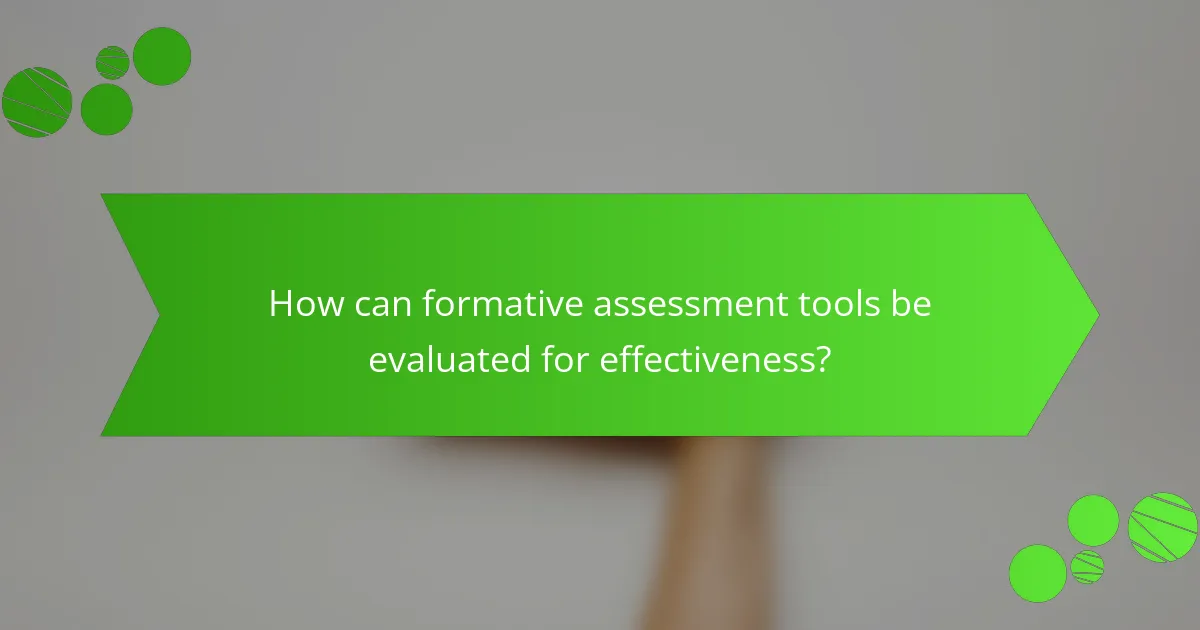
How can formative assessment tools be evaluated for effectiveness?
Formative assessment tools can be evaluated for effectiveness through several criteria. First, alignment with learning objectives is crucial. Tools should directly measure the intended learning outcomes. Second, feedback quality must be assessed. Effective tools provide actionable and timely feedback to students. Third, student engagement levels should be monitored. Higher engagement often indicates effective assessment tools. Fourth, data analysis is important. Analyzing student performance data can reveal tool effectiveness in improving learning. Fifth, teacher perceptions can provide insights. Educators’ experiences with the tools can gauge their practicality and impact. Lastly, longitudinal studies can offer evidence of sustained effectiveness over time. Research supports these criteria, emphasizing their role in enhancing educational outcomes.
What metrics should be used to assess the impact of formative assessments on student learning?
Metrics to assess the impact of formative assessments on student learning include student performance data, engagement levels, and feedback quality. Student performance data can be measured through scores on quizzes, assignments, and tests before and after formative assessments. Engagement levels can be assessed through participation rates in discussions and activities during assessments. Feedback quality can be evaluated by analyzing the specificity and usefulness of feedback provided to students. Research shows that formative assessments lead to improved learning outcomes, as evidenced by a study conducted by Black and Wiliam (1998) which highlighted that effective feedback can enhance student understanding and performance.
How can educators gather student feedback on formative assessment tools?
Educators can gather student feedback on formative assessment tools through surveys and questionnaires. These tools allow students to express their opinions on the effectiveness of assessments. Educators can design questions that focus on clarity, relevance, and engagement. Anonymous feedback encourages honesty and increases participation. Additionally, educators can hold focus groups for in-depth discussions. Observations during assessments can also provide valuable insights. Implementing feedback loops ensures that student input is considered in future assessments. Research shows that involving students in feedback processes enhances their learning experience.
What role does reflection play in improving formative assessment practices?
Reflection plays a critical role in improving formative assessment practices. It enables educators to evaluate their teaching effectiveness. Through reflection, teachers can identify areas for improvement in their assessment methods. This process encourages adjustments based on student feedback and performance data. Research indicates that reflective practices lead to enhanced student engagement and learning outcomes. A study by Dewey (1933) emphasizes that reflective thinking promotes deeper understanding. By analyzing their assessments, educators can align their strategies with student needs. This iterative process fosters a culture of continuous improvement in educational practices.
What are practical tips for maximizing the impact of formative assessment tools in economics education?
Utilize diverse formative assessment tools to enhance student engagement in economics education. Incorporate quizzes, polls, and peer assessments regularly. These methods provide immediate feedback and encourage active participation. Tailor assessments to align with learning objectives for clearer relevance. Use technology tools like online platforms to streamline data collection and analysis. Analyze assessment results to identify learning gaps and adjust teaching strategies accordingly. Foster a growth mindset by emphasizing improvement over grades. Encourage student reflection on their learning process to promote self-awareness. Implementing these strategies can significantly enhance the effectiveness of formative assessments in economics education.
How can educators create a supportive environment for formative assessments?
Educators can create a supportive environment for formative assessments by fostering a culture of trust and open communication. Establishing clear expectations helps students understand the purpose of assessments. Providing timely feedback encourages continuous improvement and learning. Incorporating student input in the assessment process promotes engagement and ownership. Utilizing diverse assessment methods caters to different learning styles and needs. Creating a safe space for students to express their thoughts reduces anxiety and enhances participation. Research shows that supportive environments lead to better student outcomes. For instance, a study by Black and Wiliam (1998) highlights the positive impact of formative assessment on student achievement.
What common pitfalls should educators avoid when implementing these tools?
Common pitfalls educators should avoid when implementing formative assessment tools include inadequate training on the tools. Educators often struggle with technology due to lack of familiarity. This can lead to ineffective use and frustration among students. Another pitfall is neglecting to align assessments with learning objectives. Misalignment can result in unclear expectations for students. Additionally, educators may overlook the importance of feedback. Without timely and constructive feedback, students cannot improve their performance. Finally, failing to involve students in the assessment process can diminish engagement. Research shows that student involvement increases motivation and ownership of learning.
Formative assessment tools in economics education are methods designed to evaluate student learning throughout the instructional process, providing ongoing feedback to enhance engagement and understanding. This article covers various types of formative assessment tools, such as quizzes, polls, and peer assessments, and discusses their effectiveness in identifying knowledge gaps and promoting active participation. Best practices for implementing these tools, including tailoring assessments to diverse student needs and utilizing technology for real-time feedback, are also examined. Additionally, the article highlights the importance of student engagement and offers strategies for creating a supportive learning environment while avoiding common pitfalls in formative assessment practices.
